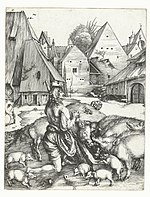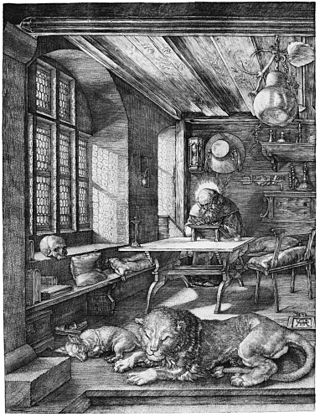The following is a very incomplete list of engravings by the German painter and engraver Albrecht Dürer.
Contents
| Image | Title | Year | Technique | Dimensions | Bartsch |
|---|---|---|---|---|---|
 | Сonversion of Paul | 1494 | Copper engraving | 295 × 217 mm | |
 | Young Woman Attacked by Death; or The Ravisher | 1495–1495 | Copper engraving | 110 × 92 mm | B92 |
 | The Great Courier | 1494–1495 | Copper engraving | 100 × 115 mm | |
 | The Holy Family with the Dragonfly | 1495 | Copper engraving | 151 × 140 mm | B44 |
 | The Ill-Assorted Couple; or the Offer of Love | 1495 | Copper engraving | 151 × 140 mm | B93 |
 | Five Lansquenets and an Oriental on Horseback | 1495 | Copper engraving | 133 × 147 mm | B88 |
 | St Jerome Penitent in the Wilderness | 1494–1498 | Copper engraving | 316 × 225 mm | B61 |
 | The Penance of St John Chrysostom | 1494–1498 | Copper engraving | 183 × 119 mm | B63 |
 | The Deformed Landser Sow | 1494–1498 | Copper engraving | 118 × 126 mm | B95 |
 | The Prodigal Son | 1494–1498 | Copper engraving | 247 × 191 mm | B28 |
 | The Small Fortune | 1495–1496 | Copper engraving | 120 × 66 mm | B78 |
 | The Small Courier | 1496 | Copper engraving | 110 × 78 mm | B80 |
 | A Cook and his Wife | 1496 | Copper engraving | 109 × 77 mm | B84 |
 | Three Peasants in Conversation | 1496–1497 | Copper engraving | 108 × 77 mm | B86 |
 | Lady on Horseback and Lansquenet | 1496–1497 | Copper engraving | 106 × 77 mm | B82 |
 | An Oriental Family | 1496–1497 | Copper engraving | 111 × 79 mm | B85 |
 | Peasant and His Wife | 1496–1498 | Copper engraving | 109 × 77 mm | B83 |
 | The Four Naked Women; or The Four Witches | 1497 | Copper engraving | 194 × 135 mm | B75 |
 | Young Couple Threatened by Death; or the Promenade | 1496–1500 | Copper engraving | 194 × 120 mm | B94 |
 | The Madonna with the Monkey | 1496–1500 | Copper engraving | 190 × 121 mm | B42 |
 | The Temptation of the Idler; or The Dream of the Doctor | 1496–1500 | Copper engraving | 190 × 121 mm | B76 |
 | The Sea Monster | 1496–1500 | Copper engraving | 248 × 189 mm | B71 |
 | Hercules at the Crossroad | 1496–1500 | Copper engraving | 320 × 222 mm | B73 |
 | Sol Justitiae; or The Judge | 1498–1501 | Copper engraving | 105 × 76 mm | B79 |
 | St Sebastian, Tied to a Column | 1497–1501 | Copper engraving | 106 × 76 mm | B56 |
 | Virgin and Child Standing on a Crescent Moon | 1498–1500 | Copper engraving | 107 × 77 mm | B30 |
 | The Man of Sorrows with Arms Outstretched | 1500 | Copper engraving | 117 × 71 mm | B20 |
 | St Sebastian, Tied To a Tree | 1499–1503 | Copper engraving | 115 × 71 mm | B55 |
 | The Virgin and Child with Saint Anne | 1500–1502 | Copper engraving | 116 × 71 mm | B29 |
 | St Eustace | 1499–1503 | Copper engraving | 359 × 261 mm | B57 |
 | The Witch | 1498–1502 | Copper engraving | 115 × 71 mm | B67 |
 | Three Putti with Trumpets, Shield, and Helmet | 1498–1502 | Copper engraving | 114 × 72 mm | B66 |
 | Nemesis; or Good Fortune | 1501–1502 | Copper engraving | 330 × 230 mm | B77 |
 | Apollo and Diana | 1501–1506 | Copper engraving | 115 × 70 mm | B68 |
 | St George on Foot | 1500–1505 | Copper engraving | 116 х 72 mm | B53 |
 | A Standard Bearer | 1502–1503 | Copper engraving | 115 х 70 mm | B87 |
 | Coat of Arms with Lion and Rooster | 1500–1503 | Copper engraving | 182 х 118 mm | B100 |
 | Madonna on a Grassy Bench | 1503 | Copper engraving | 114 × 71 mm | B34 |
 | Coat of Arms with a Skull | 1503 | Copper engraving | 220 × 158 mm | B101 |
 | Nativity | 1504 | Copper engraving | 186 × 120 mm | B2 |
 | Adam and Eve | 1504 | Copper engraving | 248 × 192 mm | B1 |
 | Satyr Family | 1505 | Copper engraving | 115 × 70 mm | B69 |
 | Small Horse | 1505 | Copper engraving | 165 × 108 mm | B96 |
 | Large Horse | 1505 | Copper engraving | 167 × 119 mm | B97 |
 | St George on Horseback | 1508 | Copper engraving | 109 × 85 mm | B54 |
 | Crucifixion | 1508 | Copper engraving | 134 × 98 mm | B24 |
 | Virgin on a Crescent with a Starry Crown | 1508 | Copper engraving | 119 × 75 mm | B31 |
 | The Holy Family with St John, The Magdalen and Nicodemus | 1510 | Drypoint | 216 × 190 mm | B43 |
 | Madonna with the Pear | 1511 | Copper engraving | 160 × 107 mm | B41 |
 | St Jerome by the Pollard Willow | 1512 | Drypoint | 208 × 185 mm | B59 |
 | Man of Sorrows with Hands Bound | 1512 | Drypoint | 118 × 74 mm | B21 |
 | Sudarium Displayed by Two Angels (Sudarium of St Veronica) | 1513 | Copper engraving | 100 × 139 mm | B25 |
 | Madonna by the Tree | 1513 | Copper engraving | 117 × 75 mm | B35 |
 | Knight, Death and the Devil | 1513 | Copper engraving | 246 × 188 mm | B98 |
 | Peasant Couple Dancing | 1514 | Copper engraving | 117 × 74 mm | B90 |
 | The Bagpiper | 1514 | Copper engraving | 116 × 75 mm | B91 |
 | St Jerome in his Study | 1514 | Copper engraving | 247 × 188 mm | B60 |
 | Madonna by the Wall | 1514 | Copper engraving | 147 × 101 mm | B40 |
 | Melencolia I | 1514 | Copper engraving | 239 × 188 mm | B74 |
 | Virgin and Child on the Crescent Moon with a Diadem | 1514 | Copper engraving | 118 × 76 mm | B33 |
 | The Apostle Paul | 1514 | Copper engraving | 118 × 74 mm | B50 |
 | The Apostle Thomas | 1514 | Copper engraving | 117 × 75 mm | B48 |
 | Man of Sorrows, Seated | 1515 | Etching | 112 × 67 mm | B22 |
 | Agony in the Garden | 1515 | Etching | 224 × 157 mm | B19 |
 | The Desperate Man | 1513–1517 | Etching | 186 × 135 mm | B70 |
 | Sudarium Spread Out by an Angel | 1516 | Etching | 184 × 133 mm | B26 |
 | Abduction of Proserpine on a Unicorn | 1516 | Etching | 315 × 211 mm | B72 |
 | The Virgin on a Crescent with a Crown of Stars and a Sceptre | 1516 | Copper engraving | 118 × 74 mm | B32 |
 | Madonna Crowned by Two Angels | 1518 | Copper engraving | 155 × 101 mm | B39 |
 | Landscape with Cannon [1] | 1518 | Etching | 218 × 324 mm | B99 |
 | Cardinal Albrecht of Brandenburg; or The Small Cardinal | 1519 | Copper engraving | 146 × 96 mm | B102 |
 | St Antony | 1519 | Copper engraving | 98 × 142 mm | B58 |
 | The Peasant and His Wife at the Market | 1519 | Copper engraving | 115 × 72 mm | B89 |
 | Madonna Nursing | 1519 | Copper engraving | 115 × 74 mm | B36 |
 | Madonna Crowned by an Angel | 1520 | Copper engraving | 138 × 99 mm | B37 |
 | Madonna with the Swaddled Infant | 1520 | Copper engraving | 141 × 96 mm | B38 |
 | St Christopher Facing to the Right | 1521 | Copper engraving | 118 × 75 mm | B52 |
 | St Christopher Facing to the Left | 1521 | Copper engraving | 118 × 75 mm | B51 |
 | Cardinal Albrecht of Brandenburg; or the Great Cardinal | 1523 | Copper engraving | 174 × 127 mm | B103 |
 | St Bartholomew | 1523 | Copper engraving | 121 × 75 mm | B47 |
 | St Simon | 1523 | Copper engraving | 118 × 75 mm | B49 |
 | Large Crucifixion in outline only | с. 1523 | Copper engraving | 320 × 226 mm | |
 | Portrait of Frederick the Wise | 1524 | Copper engraving | 193 × 126 mm | B104 |
 | Willibald Pirckheimer | 1524 | Copper engraving | 182 × 111 mm | B106 |
 | St Philip | 1526 | Copper engraving | 122 × 76 mm | B46 |
 | Philipp Melanchthon | 1526 | Copper engraving | 177 × 127 mm | B105 |
 | Erasmus of Rotterdam | 1526 | Copper engraving | 249 × 193 mm | B107 |
 | Man of Sorrows by the Column (Passion No. 1) | 1509 | Copper engraving | 117 × 74 mm | B3 |
 | Agony in the Garden (Passion No. 2) | 1508 | Copper engraving | 117 × 74 mm | B4 |
 | Betrayal of Christ (Passion No. 3) | 1508 | Copper engraving | 117 × 74 mm | B5 |
 | Christ before Caiaphas (Passion No. 4) | 1512 | Copper engraving | 117 × 74 mm | B6 |
 | Christ before Pilate (Passion No. 5) | 1512 | Copper engraving | 117 × 74 mm | B7 |
 | Flagellation (Passion No. 6) | 1512 | Copper engraving | 117 × 74 mm | B8 |
 | Christ Crowned with Thorns (Passion No. 7) | 1512 | Copper engraving | 117 × 74 mm | B9 |
 | Ecce Homo (Passion No. 8) | 1512 | Copper engraving | 117 × 74 mm | B10 |
 | Pilate Washing his Hands (Passion No. 9) | 1512 | Copper engraving | 117 × 74 mm | B11 |
 | Bearing of the Cross (Passion No. 10) | 1512 | Copper engraving | 117 × 74 mm | B12 |
 | Crucifixion (Passion No. 11) | 1511 | Copper engraving | 117 × 74 mm | B13 |
 | Lamentation over Christ (Passion No. 12) | 1512 | Copper engraving | 117 × 74 mm | B14 |
 | Deposition (Passion No. 13) | 1512 | Copper engraving | 117 × 74 mm | B15 |
 | Harrowing of Hell; or Christ in Limbo (Passion No. 14) | 1512 | Copper engraving | 117 × 74 mm | B16 |
 | Resurrection (Passion No. 15) | 1512 | Copper engraving | 117 × 74 mm | B17 |
 | St Peter and St John Healing the Cripple (Passion No. 16) | 1513 | Copper engraving | 117 × 74 mm | B18 |

















